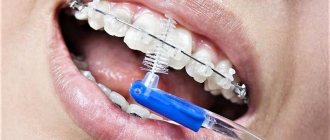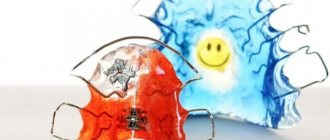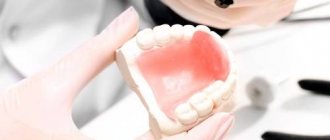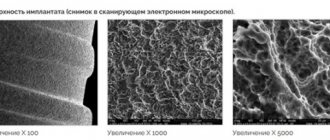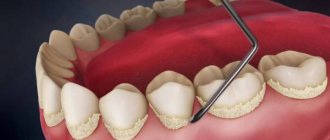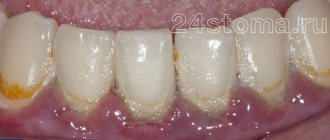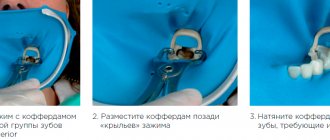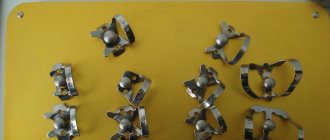Rubberdam (cofferdam) - protective dental screen (gasket) made of latex: with its help, the doctor isolates the teeth being manipulated from the rest of the oral cavity. This ensures the sterility of the working area during root canal treatment, restoration of broken teeth, prosthetics (crowns and bridges), installation of veneers, etc.
Rubberdam is a stretchy elastic napkin 5x5 or 6x6 centimeters made of latex or nitrile (for patients with latex allergies). Some dentists prefer brightly colored sheets to increase light in the work area. Others choose dark materials so that the tooth stands out against their background.
What is hidden behind complex names and when to use these tools
Today it is difficult to argue with the fact that in dentistry the level of development of advanced technologies has made it possible to significantly improve the quality of services and bring them to a fundamentally new level. But not all patients clearly understand that dental treatment or restoration largely consists of many little details that are invisible to the average person, each of which is individually important and irreplaceable.
For example, a rubber dam in dentistry. Having heard about it, many believe that this is just another way to extract money from a patient, and do not even suspect that the product can bring significant benefits and contribute to achieving the most positive result. How? Read about this in the material prepared below.
What is a rubber dam?
So, rubber dam in dentistry - what is it? Take a look at the photo. This is a latex plastic material. The doctor first places it on the patient’s oral cavity before starting treatment, after which he makes the necessary hole to isolate the working area under one, sometimes several teeth. That is, in essence, it allows you to isolate the working field, remove all unnecessary things that may interfere.
The specialist fixes the device using a special frame or clamps, ensures the required level of lip tension and gets to work.
On a note! Have you heard about optidam in dentistry, but have no idea what rubberdam and rubber dam are? It will be useful for you to know that these are the same thing, the only differences are in the names and their translation from English. But the essence of these devices is the same - to ensure sterility and isolation of the working field.
General overview
A rubber dam is a material with which the dentist isolates a diseased tooth during treatment.
Most often this term refers to a piece of latex with a hole. In fact, this is a broader concept, since in addition to standard 15x15 cm flaps, there are also rolled forms of rubber dam, three-dimensional latex plates, as well as its liquid version.
The invention is not new at all. Dental treatment using this technology was first performed in the mid-19th century. Who owned the original idea is a moot point, since both the Frenchman La Roche and the American Sanford Christie Burnim claimed authorship.
One way or another, but since 1867, rubber dam (from the German Kofferdam) or rubber dam (English version Rubberdam) have entered the practice of dentists everywhere.
The traditional material for rubber dam is cis-1,4-polyisoprene, obtained from the sap of a tropical plant - Hevea brasiliensis.
Nowadays, International Rules for performing a number of dental procedures require the mandatory use of a rubber dam.
Cofferdam: long-forgotten old or new in dentistry
A rubber dam or dental rubber dam allows dental treatment to be performed quickly, reliably, and conveniently. But not everyone knows that this device is not a trend of progress at all, but a long-forgotten old one. Thus, the product was first presented to the public more than 100 years ago. It was invented by an American dentist: in those days the system was successful, but was gradually forgotten by doctors. This happened because it did not directly affect the outcome of treatment, plus it increased material costs. Therefore, only a small part of doctors were ultimately inclined to use it, and then it was used only for endodontic treatment.
Today, increased demands are placed on sterility and quality of work performed. Plus, innovations have appeared - restorations using modern materials, whose quality and perfection are steadily growing - which was not the case before. All this requires a high degree of preparation, which is why the rubber dam in dentistry has again gained popularity.
Write a comment
Zulfiya
April 16, 2022 at 02:59 pm
We came with the child for a consultation, the doctor persuaded her, looked at her teeth, persuaded her for about 10 minutes, but seemed to have found a contact. I was already happy, I thought we would get my teeth fixed by this aunt. This aunt counted us as much as 18,000 rubles. for 4 teeth! I made an approximate calculation, I read it at home, I found this rubber dam there as many as 4 times for 850 rubles! And why such expenses? I called them and asked why we needed this, since our whole life we had been treating our teeth without it. To which I was told that according to some international standards, children’s teeth are supposed to be treated only with this gasket. It’s terrible, now I’m thinking about looking for a new clinic and trying to persuade the child to try a new one.
Renat
April 16, 2022 at 9:21 pm
It's good that they invented this latex napkin. However, the method only recently reached our city. Convenient, just beyond words. You can swallow normally, nothing runs into your mouth. True, your mouth gets extremely dry and you only need to breathe through your nose, since your mouth turns out to be blocked and you can’t breathe through a napkin.
Anton
April 18, 2022 at 02:44 pm
This may be a cool thing, but not all doctors know how to use it. I went to read how they put it on and realized that not everyone can do it. Despite the fact that all my teeth are in place and not destroyed, my dentist tried to pull this scarf on for about 15 minutes, together with the nurse. They calculated something, adjusted things, and in the end they almost gouged out my eye with some piece of iron that flew out of their hands. In short, no thanks, I’d rather sit with cotton balls behind my cheeks. I want to warn everyone, before agreeing, first ask the doctor how many of these scarves she has already worn during her work
Mark Alexandrovich
July 22, 2022 at 12:39 pm
This may be a cool thing, but not all doctors know how to use it. I went to read how they put it on and realized that not everyone can do it. Despite the fact that all my teeth are in place and not destroyed, my dentist tried to pull this scarf on for about 15 minutes, together with the nurse. They calculated something, adjusted things, and in the end they almost gouged out my eye with some piece of iron that flew out of their hands. In short, no thanks, I’d rather sit with cotton balls behind my cheeks. I want to warn everyone, before agreeing, first ask the doctor how many of these scarves she has already worn during her work
Valentina
July 22, 2022 at 21:00
We came with the child for a consultation, the doctor persuaded her, looked at her teeth, persuaded her for about 10 minutes, but seemed to have found a contact. I was already happy, I thought we would get my teeth fixed by this aunt. This aunt counted us as much as 18,000 rubles. for 4 teeth! I made an approximate calculation, I read it at home, I found this rubber dam there as many as 4 times for 850 rubles! And why such expenses? I called them and asked why we needed this, since our whole life we had been treating our teeth without it. To which I was told that according to some international standards, children’s teeth are supposed to be treated only with this gasket. It’s terrible, now I’m thinking about looking for a new clinic and trying to persuade the child to try a new one.
Stas
July 24, 2022 at 10:18 am
It's good that they invented this latex napkin. However, the method only recently reached our city. Convenient, just beyond words. You can swallow normally, nothing runs into your mouth. True, your mouth gets extremely dry and you only need to breathe through your nose, since your mouth turns out to be blocked and you can’t breathe through a napkin.
Indications and scope of application of rubber dam
In what areas of dental services is rubber dam installation used:
- Endodontics: This branch involves treating the root canals of a tooth. And here it is very important not only to maintain perfect sterility, but also to prevent medicinal compounds from getting into the surrounding mucous membrane of the patient, so as not to cause an allergic reaction. It is also important to protect the area from liquids, i.e. saliva,
- light fillings and artistic restorations: for high-quality adhesion of the composite and photopolymer to the walls of the tooth, their adhesion, the condition of the absence of moisture, foreign liquid, saliva must be observed, which ensures the device,
- enamel whitening: the purpose of the rubber dam in this case is to protect the mucous membrane from the temperature effects of lamps, chemical bleaches,
- fissure sealing,
- splinting of teeth.
Pros for dentists
Using a rubber dam makes the dentist's job much easier as it provides good visibility and access even in hard-to-reach areas of the mouth. Other benefits are as follows:
- There is no need to be distracted by auxiliary manipulations in the form of removing liquid or replacing cotton swabs, since the area is reliably protected from blood, saliva and other liquids;
- The risk of infection and contamination of the working area with pathogenic organisms is eliminated, therefore risks such as relapse of caries or infection during dental canal treatment are practically reduced to zero;
- Improving the quality of prosthetics and installation of fillings, their durability by eliminating the entry of biological fluids into the working area, which reduce adhesion.
Benefits of use for the doctor and patient
The use of a rubber dam in dentistry brings great benefits to both the doctor and the patient. Let's look at which one.
For the doctor: the ability to concentrate on work, convenient access to the desired tooth, improved visibility of the working field, dryness, cleanliness, sterility. The doctor can also easily monitor the condition of the tooth and the mucous membrane around it, stopping bleeding in time and carrying out disinfection. He spends his time rationally and can do without additional devices - a saliva ejector, cotton sponges.
For the patient: applying Optidam allows him to feel protected and not worry about the doctor injuring the lips, adjacent teeth, gums, mucous membranes, and the inside of the cheeks. A person can easily swallow saliva, because it will not harm the treatment process, and besides, medications, instrument fragments, and foreign impurities will not get into it. You also won’t have to spit or rinse your mouth often. Muscles and joints get less tired, because... treatment time is reduced. All this creates a feeling of some comfort.
Purposes of application
Working with a rubber dam in dentistry is the key to protection against cross-infections and the confidence that the inflammatory process from a tooth during its treatment will not spread to neighboring ones. In addition, the installed filling or restoration will last much longer than it would have without the use of latex protection. After all, this ensures the dryness of the working space, and if saliva and breath vapors get inside, the adhesion of the filling material would be much less, and the treatment would be more effective.
It turns out that the main goal is to improve the level of quality of service, save in the long term, and be able to maintain the health of the oral cavity, teeth and gums.
Reviews
Over its long history, cofferdam has earned many positive ratings, both among professional doctors and patients.
Do you have experience with latex curtain? What do you think about her? You can leave your comment here.
If you find an error, please select a piece of text and press Ctrl+Enter.
Tags toothache treatment
Did you like the article? stay tuned
Previous article
Is your child afraid of the dentist? Get him out of trouble!!!
Next article
Correction of a gummy smile using gingivectomy
Disadvantages and contraindications
The application of a rubber dam in dentistry is contraindicated for people with nasal breathing problems, because If isolation is applied to the mouth, such a patient will have difficulty breathing. They are not suitable for people prone to epileptic seizures, with Alzheimer's disease, or with allergic reactions to latex, rubber, or talcum powder.
As for the disadvantages of use, they also exist: an unprofessional doctor can spend quite a lot of time installing the device, and it can touch and injure the interdental papillae. This procedure cannot be done without an assistant or assistant. It is best to install a latex napkin in four hands. Also, the doctor may have difficulty selecting the shade of the tooth to be restored with direct restorations, because the rest of the dentition in this case is hidden under the cloth.
Well, and most importantly, this, although slightly, increases the total cost of treatment. But as studies show, 99 patients out of 100 patients would agree to the use of such measures even taking into account the increase in price - but doctors do not always offer it, and patients do not know about this.
Types and properties of rubber dams
- a classic of the genre: the classic dental rubber dam is made of rubber, which comes in different thicknesses and densities. The most popular option is the average value up to 0.23 millimeters; they are universal for any medical manipulation. Thick and extra-thick are mainly used for gum retraction - their density ranges from 0.29 to 0.38 millimeters. Also, sometimes individual optids are made on special orders when certain conditions must be met,
- liquid rubber dam: it is based on a helium component, which, when applied, spreads evenly and polymerizes under the influence of light, hardens in the interdental spaces and on the gums. It is lightweight and easy to use. The main scope of application is whitening, removal of dental plaque and calculus during professional hygiene, an additional measure of protection in combination with a rubber dam during endodontic treatment of canals.
The color of the device also matters:
- light shades: for example, light beige is suitable for treating and filling tooth canals. The material in this shade turns out to be almost transparent, which makes it possible to perform high-quality tooth restoration and determine its exact position, direction, and shape. Blue, pink, marble colors of rubber dam can also be used for these purposes - but they are used less often,
- dark shades: green, gray, blue are used in restorations and allow you to determine the color, shape, and condition of adjacent elements of the dentition to select the desired shade.
Liquid material
Rubber dam in the form of methacrylate gel is a good solution for many dental procedures.
First of all, it is easy to apply, effectively isolates the gums, penetrating into the most difficult interdental areas.
The method of applying it is as follows: retractors are placed in the oral cavity to move the cheeks and tongue, a saliva ejector is inserted and the working surface is dried using cotton rolls.
Then the periodontal tissues are covered with a gel, which polymerizes in 20 seconds. The patient is ready for further manipulations. The protective material is removed with careful movements using a special trowel.
Since the liquid version does not protect the entire oral cavity, its main areas of application are:
- professional enamel whitening;
- microabrasion.
Liquid rubber dam is used when additional protection is needed for gums covered with a classic latex curtain.
What tools does a doctor need to fix the rubber dam?
The installation of a rubber dam in dentistry should be carried out by a specialist using special auxiliary tools: a stencil or template (marker) to accurately determine the location of the tooth and select the place where the hole needs to be made. The doctor will also need a punch - this is a tool that will help make a cut on the latex sheet. The doctor must also have special fastening elements, fixing the rubber sheet: frame, staples and clamps (they differ depending on which tooth should be treated - there are types for upper and lower molars, premolars, central teeth and roots) clamps, floss and dental floss.
How does a doctor install a rubber dam?
There is absolutely no need to be afraid of the procedure. There are even several rubber dam techniques that a doctor can use depending on the situation.
- "Wings". This option involves the use of a frame and a clamp; it is designed to work with molars and premolars.
- Work in tandem with an assistant. In this embodiment, the doctor cannot do all the work himself; he needs the help of a person who will hold the insulating sheet on the frame. The doctor himself will fasten the clamps. Ideal for working with any teeth.
- The work begins with installing a clamp on the tooth, and only then the latex scarf and frame are applied.
- Arc method. Used when it is necessary to treat the lower teeth. It can be quite sensitive, so your doctor will administer anesthesia before using it.
While the complexities of installing the curtain and its nuances can only be understood by a professional, the process of removing the protective material is very easy and simple: when working with one tooth, after removing the clamp, the latex is easily removed. When treating several elements of the dentition, it is removed using special scissors.
Alternatives
The main role of the rubber dam is to ensure the isolation of the tooth from possible moisture. Traditionally, this is solved using cotton rolls that are placed around the tooth. But they have to be changed frequently, they interfere with the dentist’s view and cause discomfort to the patient.
A more modern option is saliva absorbent pads (Dry Tips) . They have greater absorbency and fit more comfortably in the mouth. But their insulating characteristics are still inferior to rubber dam.
For timely removal, a saliva ejector is used . But its use requires the constant presence of an assistant. This device takes up a certain place in the mouth and can interfere with the dentist’s work.
The following isolation methods are less often practiced:
- retraction thread;
- fum tape;
- liquid rubber dam;
- Tofflmayr matrix holder with metal matrices;
- sectional matrices and wooden wedges.
Learn about the advantages of the device and one of the application methods from the video.
